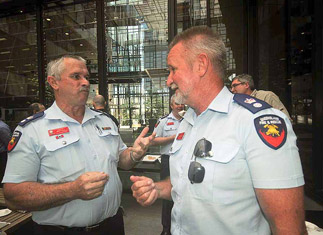At the invitation of the Queensland Government, TERN delivered a briefing session to introduce a range of new, free remote-sensing products relevant to assessing fuel loads, fire risk, and fire history to a wide range of local and state-based stakeholders.
The session, which was held in Brisbane on 16 November, was hosted by the Department of Science, Information Technology, Innovation and the Arts (DSITIA) at the EcoSciences Precinct, and the 51 attendees were a diverse mix of fire researchers, managers and practitioners from non-government organisations (NGOs), government departments, research organisations and natural resource management groups. Attending online via webinar were representatives from as far afield as the University of Technology Sydney, the South Australian Department of Environment, Water and Natural Resources, and Cape York Sustainable Futures.
Queensland Chief Scientist Dr Geoff Garrett AO opened the day, declaring his support for cooperative initiatives such as these because they encourage more effective translation of research into policy and practice. Queensland Fire and Emergency Services Deputy Commissioner Iain McKenzie highlighted how critical open access to data is – he mentioned its capacity to save lives – in the context of predicting and managing fires. In his follow-up article for the Courier-Mail newspaper, journalist Brian Wilson made much of the importance of better access to credible information – one of TERN’s basic tenets – on fire.
The range of validated remote-sensing products and associated field data, which are available through TERN’s AusCover facility was introduced. AusCover Director Dr Alex Held, Matt Paget from CSIRO in Canberra, and Dr Peter Scarth from the University of Queensland and DSITIA explained the products and data. Among the tools for assessing fuel load and type are the newly validated national-scale fractional-cover algorithm, called Persistent Green. Links to many of these products and their underlying datasets can be found on AusCover’s online data console.
Terry Webb, a spatial analyst from the Australian Wildlife Conservancy, was there to learn more about remote-sensing products that could help the organisation conduct its fire-management and carbon-emissions projects in northern Australia.
‘As Geoff Garrett said, events like this are also valuable because they provide us with opportunities to meet others working in these fields,’ Terry said.
The capacity for TERN to act as an integrator, or catalyst for collaboration, between groups that do not normally interact was also raised during discussions at the end of the session. Participants noted the potential for TERN’s infrastructure and products to increase the capacity for greater sharing and understanding of information and, therefore, increasingly informed assessments of regional fire risk – especially by relatively small, under-resourced agencies and groups – before each fire season.
Using the products presented as a springboard, participants discussed the next stage in providing integrated information that was still needed, and ways to continue the conversation.
Fourteen of the attendees submitted anonymous evaluation forms, and the results indicate that the session was useful in increasing awareness of TERN’s aims, scope and relevance in the context of fire risk. Qualitative feedback provided on the forms will help TERN to further refine these engagement sessions.
Special thanks to Director-General Kelvin Anderson from the Queensland Department of Community Safety, and Assistant Director-General Dr Christine Williams and staff of DSITIA’s Science Delivery Divison for their help and interest in this session.


Dr Geoff Garrett (photo at left) speaks at the opening of the TERN–Queensland Government briefing on fire risk, which was attended (photo at right) by Fergus Adrian (left) and Bernard Trembath (right) from the Queensland Department of Fire and Emergency Services
Published in TERN e-Newsletter November 2012






